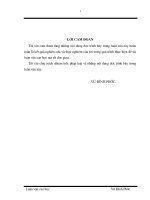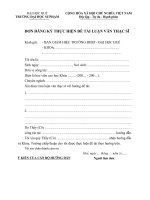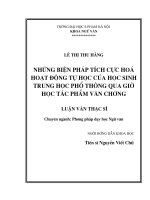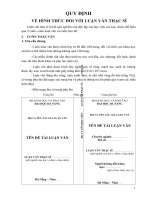(Luận văn thạc sĩ) profitability and risk of banks pre and post mas preliminary evidence from vietnam
Bạn đang xem bản rút gọn của tài liệu. Xem và tải ngay bản đầy đủ của tài liệu tại đây (144.59 KB, 10 trang )
Vo Xuan Vinh | 771
Profitability and risk of banks pre and post M&As:
Preliminary evidence from Vietnam
VO XUAN VINH
University of Economics Ho Chi Minh City
CFVG Ho Chi Minh City
Email:
Abstract
The conduct of Mergers and Acquisitions (M&As) of commercial banks is an important activity
in order to fulfil the strategic objectives of all banks involved. However, M&As activities in
Vietnamese banking sector have unique characteristics because most of the recent deals are
arranged by central bank and other financial regulatory authority bodies with the purpose of
achieving a prudential financial system. This article examines the effects of M&As in banking
sector by analyzing profits and risks of commercial banks pre and post M&As in the recent
liberalization episode in Vietnam. The preliminary result suggests that most of commercial banks
experience lower profits and higher credit risks after M&A. Hence, it seems that most of banks
face more difficulties after M&A.
Keywords: mergers and acquisitions; Vietnam; commercial banks.
1. Introduction
The banking system is facing significant challenges due to fundamental changes in
regulation and technology. In the last few decades, there is an unprecedented wave of
consolidation in the financial sector (Amel et al., 2004). Mergers and Acquisitions (M&As)
of commercial banks is an important strategy to achieve the strategic objectives of
financial institutions. These M&As are popular strategies and widely employed by
commercial banks, insurance companies and other financial institutions.
In Vietnam, recent M&A activities in banking sector is an important step conducted by
the Vietnamese government in restructuring the banking sector. Clearly, M&A activities
might not reflect the will of the financial institutions but the will of the central bank, the
772 | ICUEH2017
State Bank of Vietnam. The communicated purpose of these mergers and acquisitions is
suggested as an important step in the restructuring process of the banking and financial
system. Moreover, most of communications also states that the main objective of mergers
and acquisitions in Vietnam banking sector is to help the merged bank to grow in scale,
improve financial strengths and minimize costs.
However, as discussed in previous section, an important and prominent feature of M
& A activity in Vietnam is that most of M&A activities in Vietnam's banking system are
aimed at implementing the restructuring strategy conducted by the State Bank of Vietnam
in order to improve the financial system. Therefore, considering the effectiveness of the
bank's profit and risk after the merger is an important task to evaluate the effectiveness
of merger.
There is a growing body of empirical literature which focus on measuring the
efficiency gains from mergers and acquisitions in the financial sector. However the
literature remains inconclusive about the effectiveness of mergers and acquisitions on
bank profitability and risk. It is likely that the results varies according to the country,
industry and time period analyzed (Amel et al. 2004). This paper aims at providing some
preliminary evidence on the profits and risks of commercial banks pre and post M&As.
We offer some preliminary evidence on the effectiveness of M&As in banking sector. This
is important to provide some initial assessment of the recent government strategy in
order to improve the soundness of the financial system in Vietnam.
The remainder of the paper is organized as follows. Section 2 provides a review of
previous papers on the impact of M&As on bank profitability and risk. Section 3 provides
the information on banks involved in M&A activities. Section 4 introduces some
preliminary evidence on profits and risks of commercial banks pre and post M&A. Section
5 provides some concluding remarks and suggests directions for future research.
2. Literature Review
A number of previous papers assess the impact of bank M&A on profitability and risk.
In this section, we provide a review of previous studies on this subject in the current
literature.
Vennet (1996) analyze the effect of mergers and acquisitions on the efficiency and
profitability of EC financial institutions. The findings from this study suggest that
Vo Xuan Vinh | 773
domestic mergers among equal-sized partners extensively improve the performance of
the merged banks. Improvement of cost efficiency is also reported in cross-border
acquisitions. However, this study highlights that domestic takeovers are influenced
predominantly by defensive and managerial motives such as size maximization.
Berger (1998) conducts estimation of the cost, standard profit, and alternative profit
efficiency effects of bank mergers of the 1990s. The finding highlights that on average,
bank mergers increase profit efficiency in comparison with other non-mergerbanks.
However, mergers do not have much impact on cost efficiency. This study also report that
efficiency gains are considerably higher when the participating banks are relatively
inefficient. This provide evidence to support the preposition that mergers may “wake up”
inefficient management. This also provide evidence to support the implementation of
unpleasant restructuring. More importantly, this study highlights that part of the
efficiency gains result from enhanced diversification of risks. This is important because
the consolidated banks undertake gradual shifting of their output mixes from risky
investment securities toward loans, thereby increasing expected revenues.
Hughes et al. (1999) state that the main motivations for mergers and acquisitions in
banking are improved potential for geographic expansion. This is achieved by differences
in state laws controlling branching and a more favorable antitrust climate. This paper
also asserts that the banks engaged in interstate expansion attain the highest economic
benefits of consolidation. More specially, banks engaged in interstate expansion also
achieve strong benefits from the diversification of macroeconomic risk. Finally, this paper
confirms the benefits of society from the enhanced bank sounness resulting from bank
consolidation.
Amel et al. (2004) provide a critical review of previous studies which analyze the major
players of the financial industry (commercial and investment banks, insurance and asset
management firms) in a number of advanced countries over an extended time frame.
This paper focus on common patterns that transcend national and sectoral peculiarities
(Amel et al. 2004). The result is quite interesting. This paper reports that consolidation
in the financial sector is beneficial up to a relatively small size. However, it is important
to note that this paper offers little evidence to confirm the economies of scope or gains in
managerial efficiency yielding from bank mergers and acquisitions (Amel et al. 2004).
774 | ICUEH2017
Nicoló et al. (2004) investigate recent trends in bank activity, consolidation,
internationalization, and financial firm conglomeration using a huge data from a large
number of countries. This paper also explores the impacts of consolidation and
conglomeration on financial firm risk and systemic risk of these involved banking firms.
The paper offers strong evidence to confirm the strong link between consolidation,
conglomeration and financial risk.
Uhde and Heimeshoff (2009) utilize aggregate balance sheet data from commercial
banks across the EU-25 over the period from 1997 to 2005. This paper offers empirical
evidence that national banking market concentration has a negative impact on financial
soundness of banks.
Halkos and Tzeremes (2013) employ a bootstrapped Data Envelopment Analysis
(DEA)-based procedure to estimate the short-run operating efficiency gains of a potential
bank merger or acquisition (M&A). This study confirms that a merger or acquisition
between efficient banks does not necessarily ensure an efficient bank M&A.
Dunn et al. (2015) examine non-government-assisted US commercial bank merger
activity prior to and during the recent financial crisis. The study suggests that overall
merger announcement value creation during the financial crisis is greater when targets
have higher quality assets, are better capitalized, and are less efficient.
3. An overview of Vietnamese commercial Banks involved in M&A
activities
Table 1 presents some basic information about mergers in the banking system in
Vietnam. This table shows that most of the mergers in Vietnam banking system are
conducted recently. Clearly, the time is not long enough to make conclusions about the
effectiveness of the merger.
Table 1
Information of Banks which are involved in merger activity
Merger
Date
Commercial Bank Involved
Bank Name in
Vietnamese
Bank Name
Post Merger
Bank Name in
Vietnamese
15-12-2011
De Nhat Joint Stock Commercial
Bank
Ngân hàng
TMCP Đệ Nhất
Sai Gon Joint
Stock
Ngân hàng
TMCP Sài Gòn
Vo Xuan Vinh | 775
Merger
Date
28-08-2012
20/12/2013
5-5-2015
12-08-2015
14/09/2015
Commercial Bank Involved
Bank Name in
Vietnamese
Bank Name
Post Merger
Tin Nghia Joint Stock
Commercial Bank
Ngân hàng
TMCP Tín
Nghĩa
Commercial
Bank
Sai Gon Joint Stock Commercial
Bank
Ngân hàng
TMCP Sài Gòn
Hanoi Housing Development
Joint Stock Bank
Ngân hàng
TMCP Nhà Hà
Nội
Saigon – Hanoi Joint Stock
Commercial Bank
Ngân hàng
TMCP Sài Gòn
Hà Nội
Ho Chi Minh Housing
Development Bank
Ngân hàng
TMCP Phát
triển nhà TP
Hồ Chí Minh
Dai A Joint Stock Commercial
Bank
Ngân hàng
TMCP Đại Á
Mekong Housing Development
Joint Stock Bank
Ngân hàng
TMCP Phát
triển Nhà Đồng
bằng Sông Cửu
Long
Vietnam Bank for Investment
and Development
Ngân hàng Đầu
tư và Phát
triển Việt Nam
Mekong Development Bank
Ngân hàng
Phát triển
Mekong
Maritime Joint Stock
Commercial Bank
Ngân hàng
TMCP Hàng
Hải
Western Bank
Ngân hàng
TMCP Phương
Nam
Sacombank
Ngân hàng
TMCP Sài Gịn
Thương Tín
Source: Tabulated by author
Bank Name in
Vietnamese
Saigon – Hanoi
Joint Stock
Commercial
Bank
Ngân hàng
TMCP Sài Gòn
Hà Nội
Ho Chi Minh
Housing
Development
Bank
Ngân hàng
TMCP Phát
triển nhà TP
Hồ Chí Minh
Vietnam Bank
for Investment
and
Development
Ngân hàng Đầu
tư và Phát
triển Việt Nam
Maritime Joint
Stock
Commercial
Bank
Ngân hàng
TMCP Hàng
Hải
Sacombank
Ngân hàng
TMCP Sài Gịn
Thương Tín
776 | ICUEH2017
4. Profits and Risks of Vietnamese banks pre and post Mergers and
Acquisitions – Some preliminary evidence
In this paper, profit of commercial bank is measured by the ROA – returns on total
assets. We use the credit risk measure to proxy for bank risk, which is calculated by the
ratio of the loan loss provision to total outstanding loans.
Figures 1 through 6 describe the profitability and riskiness of the banking system in
Vietnam. In general, we find the preliminary evidence that the profitability of merging
banks has decreased and risk has increased after mergers.
2.32%
2.50%
1.67%
1.16%
1.41% 1.38%
1.12%
1.09%
0.84%
0.49% 0.41% 0.50% 0.41%
0.76% 0.78% 0.73%
0.73%
0.54%
0.72%
0.00% 0.05% 0.03% 0.05% 0.04%
2004
2005
2006
2007
2008
2009
ROA
2010
2011
2012
2013
RISK
Figure 1. Profit and Risk of SCB for the period from 2004 to 2015
Source: author’s calculation
2014
2015
Vo Xuan Vinh | 777
2.20%
1.87%
1.71%
1.51%
1.42%
0.99%
1.41%
1.22%
1.29%
1.12%
1.01%
0.74%
0.30%
2006
1.55%
0.70%
0.74%
2013
2014
1.08%
0.50%
0.41%
0.19%
2007
2008
2009
2010
2011
ROA
2012
2015
RISK
Figure 2. Profit and Risk of SHB for the period from 2006 to 2015
Source: author’s calculation
2.34%
2.11%
1.58%
1.33%
1.21%
0.87%
0.84%
0.65%
0.69%
1.02%
0.78%
1.26%
1.03%
0.73%
1.15%
0.92%
0.81%
0.40%
2005
2006
2007
0.63%
0.74%
0.28%
2008
2009
2010
ROA
2011
2012
2013
2014
RISK
Figure 3. Profit and Risk of HDB for the period from 2005 to 2015
Source: author’s calculation
1.25%
2015
778 | ICUEH2017
2.55%
2.62%
2.20%
2.08%
1.99%
1.74%
1.46%
0.75%
2006
0.99%
1.22%
1.26%
0.95%
1.04%
1.57%
1.49%
0.96%
0.97%
0.93%
2013
2014
2015
0.70%
2007
2008
2009
2010
ROA
2011
2012
1.26%
RISK
Figure 4. Profit and Risk of BIDV for the period from 2006 to 2015
Source: author’s calculation
2.59%
2.68%
2.31%
1.28%
1.27%
1.37%
0.53%
1.34%
0.76%
1.57%
1.32%
0.73%
0.97%
0.97%
0.91%
0.23%
2006
2007
2008
2009
2010
ROA
2011
2012
0.37%
2013
0.16%
0.15%
2014
2015
RISK
Figure 5. Profit and Risk of MSB for the period from 2006 to 2015
Source: author’s calculation
2.14%
Vo Xuan Vinh | 779
2.47%
2.45%
2.09%
0.57%
0.50%
0.72%
1.96%
1.68%
1.62%
0.86%
0.99%
1.83%
1.50%
1.01%
1.49%
1.22%
0.90%
1.07%
1.23%
1.23%
0.50%
0.16%
2006
2007
2008
2009
2010
2011
ROA
2012
2013
2014
2015
2016
RISK
Figure 6. Profit and Risk of STB for the period from 2006 to 2016
Source: author’s calculation
5. Concluding remarks and Direction for future research
Typically, mergers and acquisitions of commercial banks not only serve the interests
of banks involved but also create benefits for the general economy. Consequently,
investigating the effectiveness of mergers and acquisitions should also consider the
interests of society in conjunction with the interests of the merging banks. Within the
framework of this study, we examine the profitability and risk of merging banks in the
past period.
This paper examines the effectiveness of the merger in Vietnamese Banking system.
Specially, we analyze the profitability and risk of Vietnamese commercial banks pre and
post mergers and acquisitions.
With preliminary data, we show that most of the banks after the mergers are facing
difficulties. This is evidenced by the reduced profitability and increased risk. However, a
deeper assessment requires longer time series.
The paper also offers some suggestions for future research. Firstly, many different case
studies should be conducted to analyze different aspects of bank operations in details.
780 | ICUEH2017
Secondly, further research on this should be conducted once the time frame is long
enough to provide a valid generalized conclusion.
References
Amel, D., Barnes, C., Panetta, F. & Salleo, C. 2004, 'Consolidation and efficiency in the financial sector: A
review of the international evidence', Journal of Banking & Finance, vol. 28, no. 10, pp. 2493-2519.
Berger, A.N. 1998, 'The efficiency effects of bank mergers and acquisition: A preliminary look at the 1990s
data', Bank Mergers & Acquisitions, Springer, pp. 79-111.
Dunn, J.K., Intintoli, V.J. & McNutt, J.J. 2015, 'An examination of non-government-assisted US commercial
bank mergers during the financial crisis', Journal of Economics and Business, vol. 77, pp. 16-41.
Halkos, G.E. & Tzeremes, N.G. 2013, 'Estimating the degree of operating efficiency gains from a potential
bank merger and acquisition: A DEA bootstrapped approach', Journal of Banking & Finance, vol. 37, no.
5, pp. 1658-1668.
Hughes, J.P., Lang, W.W., Mester, L.J. & Moon, C.-G. 1999, 'The dollars and sense of bank consolidation',
journal of banking & finance, vol. 23, no. 2, pp. 291-324.
Nicoló, G.D., Bartholomew, P., Zaman, J. & Zephirin, M. 2004, 'Bank consolidation, internationalization,
and conglomeration: Trends and implications for financial risk', Financial markets, institutions &
instruments, vol. 13, no. 4, pp. 173-217.
Uhde, A. & Heimeshoff, U. 2009, 'Consolidation in banking and financial stability in Europe: Empirical
evidence', Journal of Banking & Finance, vol. 33, no. 7, pp. 1299-1311.
Vennet, R.V. 1996, 'The effect of mergers and acquisitions on the efficiency and profitability of EC credit
institutions', Journal of Banking & Finance, vol. 20, no. 9, pp. 1531-1558.









